Congratulations! You’ve got your treadmill set up, you understand the basics from our Ultimate Beginner’s Guide to Treadmills, and now you’re ready for the exciting part – actually using it!
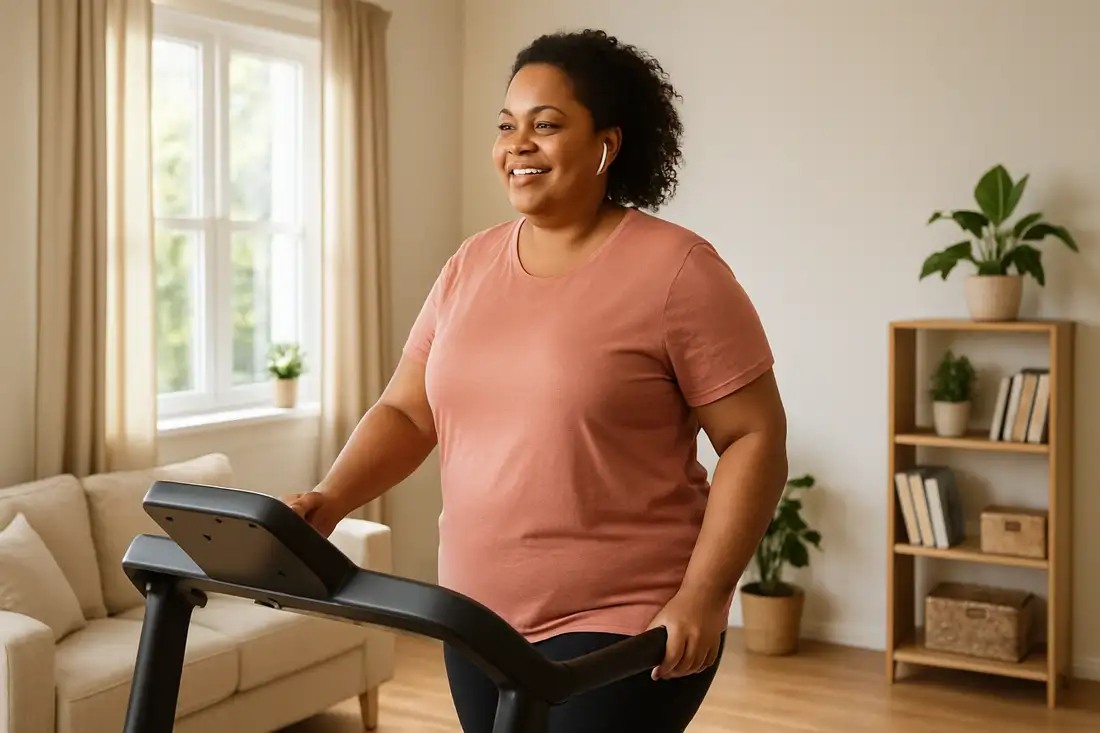
But maybe you’re thinking, “Okay… now what exactly do I do?” It’s a common question!
Don’t worry, starting out doesn’t need to be complicated. This guide provides simple, structured workout “building blocks” perfect for beginners.
We’ll focus on foundational walking, gently introduce incline work (hills!), and guide you through your first steps into basic interval training with light jogging.
Crucially, we’ll help you understand effort levels (how hard it feels) rather than just prescribing strict speeds, making these workouts adaptable to your unique fitness level right now.
Safety First! This guide assumes you’ve thoroughly read and understood our essential Treadmill Safety Guide and are comfortable with your machine’s basic controls Key Treadmill Features Explained.
Always prioritize safety!
Before You Start ANY Workout – The Golden Rules
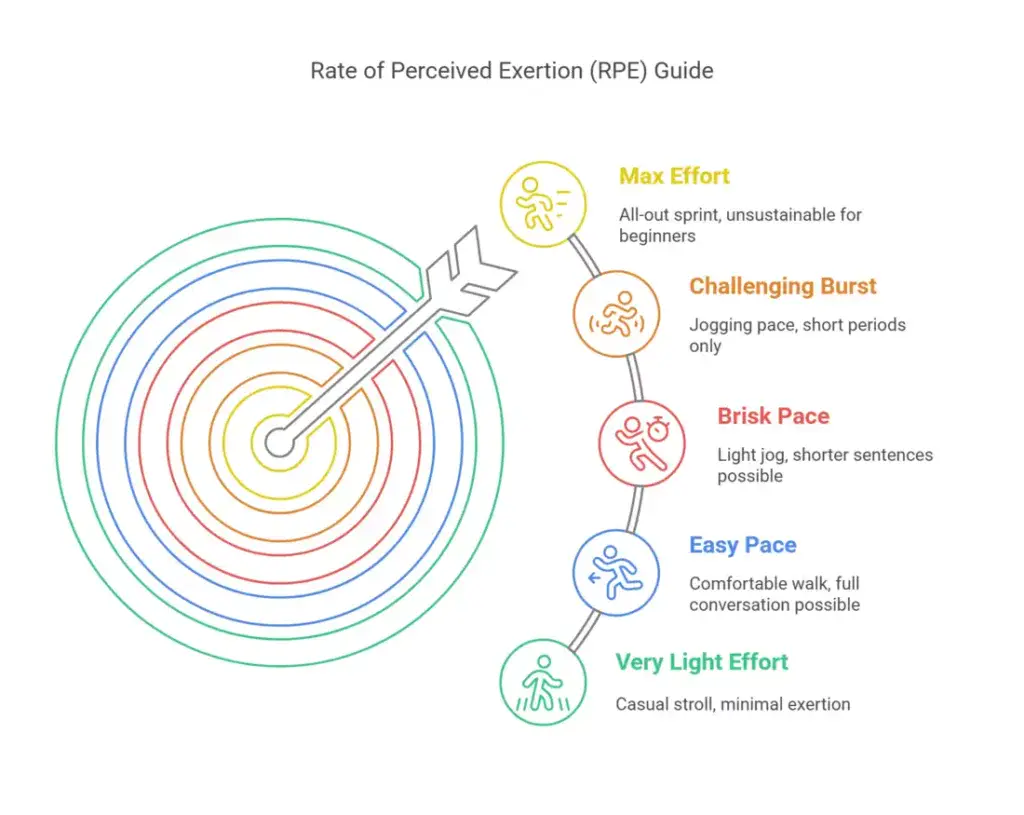
Think of these as your essential principles for every single treadmill session.
Internalizing these rules ensures your workouts are safe, effective, and sustainable.
- Listen to Your Body (Rule #1!): This is non-negotiable. Your body sends signals. If you feel sharp pain, dizziness, lightheadedness, or excessive discomfort, slow down or stop immediately. It’s okay to have days where you feel less energetic – adjust your workout accordingly. Pushing through pain, especially as a beginner, often leads to injury or burnout.
- Warm-Up & Cool-Down are Mandatory: Think of them as the bookends to your workout. A warm-up (getting muscles ready) prepares your body for exercise, reducing injury risk. A cool-down (gradually returning to rest) helps your heart rate recover safely and can improve flexibility. Every workout structure in this guide includes them.
- Understanding Your Effort Level (RPE Explained Simply): Forget just looking at speed numbers! How hard a workout feels is a much better guide, especially when starting. We use the Rate of Perceived Exertion (RPE) scale, typically rated from 1 (no effort) to 10 (max effort). Here’s a simple guide for beginners:
- RPE 1-2: Very, very light effort. Like casually strolling through a shop.
- RPE 3-4: Easy Pace. Comfortable walk, you can easily carry on a full conversation without pausing for breath.
- RPE 5-6: Brisk Pace. Purposeful walk or a very light jog. Your breathing is noticeable; you can talk, but only in shorter sentences.
- RPE 7-8: Challenging Burst. Jogging or running at a pace where talking more than a word or two feels difficult. Sustainable for short periods only as a beginner.
- RPE 9-10: Very Hard / Max Effort. All-out sprint. Avoid this intensity level when starting out.
- Key Point: The speed (mph/kph) that corresponds to each RPE level is different for everyone and will change as you get fitter! Focus on the feeling.
Workout Building Block #1 – The Foundation Walk (Focus – Consistency & Comfort)
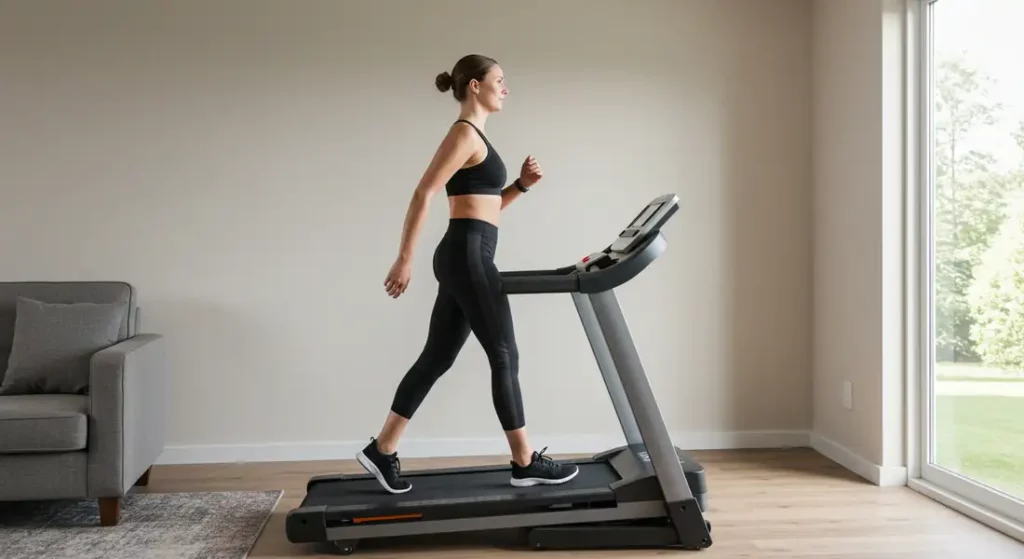
This is your starting point. The goal here is simply to get comfortable moving on the treadmill, build consistency, and get used to maintaining a steady, easy effort level.
- Goal: Build endurance base, establish routine, learn treadmill comfort.
- Structure:
- Warm-Up (5 min): RPE 2-3 (Start with a very slow walk, gradually increasing to an easy pace. Keep incline at 0%).
- Main Set (15-25 min): Maintain RPE 3-4 (Easy Pace walk. You should be able to chat comfortably. Keep incline minimal, 0-1%). Focus on a steady, consistent rhythm.
- Cool-Down (5 min): RPE 2-3 (Gradually slow down to a very slow walk. Incline at 0%). Follow with gentle stretching for major leg muscles (quads, hamstrings, calves) once you are off the treadmill.
- Beginner Tip: Don’t worry about speed initially. Focus on completing the planned duration comfortably and consistently showing up for your workouts.
- Progression: Once this feels easy for a week or two, the simplest way to progress is to gradually increase the duration of the Main Set by 2-5 minutes each week.
Workout Building Block #2 – The Gentle Hill Explorer (Focus – Adding Intensity Mildly)
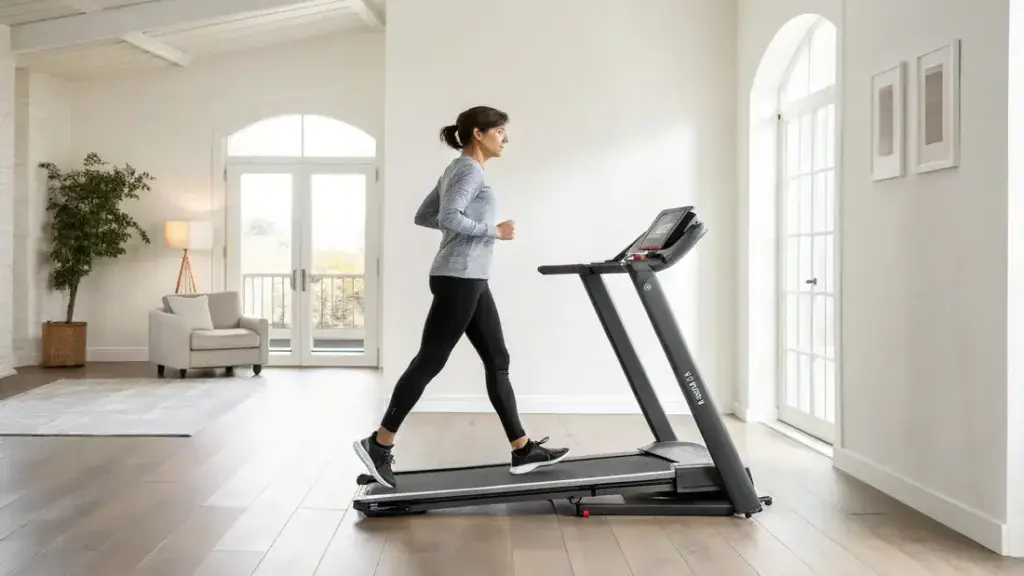
Ready for a small challenge?
Adding incline is a fantastic way to increase workout intensity and work your leg muscles differently (hello, glutes and hamstrings!) without needing to walk faster or start jogging.
- Goal: Introduce slight intensity variation, engage different muscles, elevate heart rate gently.
- Structure:
- Warm-Up (5 min): RPE 2-3 (Slow to easy pace walk, 0% incline).
- Main Set (15-25 min): Alternate between these two phases:
- Flat Road (3-4 minutes): RPE 4-5 (Find a Brisk Pace walk where you feel slightly breathless but can still talk in shorter sentences. Keep incline low, 0-1%).
- Gentle Hill (1-2 minutes): Maintain the same walking speed but increase the incline to 2-4%. Your RPE will likely increase slightly (maybe RPE 5-6). Focus on pushing through the incline while keeping your pace steady.
- Repeat this flat/hill cycle throughout the main set duration.
- Cool-Down (5 min): RPE 2-3 (Slow walk, return incline to 0%), followed by stretching, paying extra attention to calves and hamstrings.
- Beginner Tip: Small incline changes make a big difference! Start with lower inclines (2-3%) and shorter hill durations (1 minute). You can always increase it next time.
- Progression: Choose one small change per week or two: Slightly increase the incline level during the hill segments (e.g., from 3% to 4%), OR slightly increase the duration of the hill segments (e.g., from 1 min to 1.5 min), OR increase the total Main Set time.
Workout Building Block #3 – First Steps Into Intervals (Focus – Introducing Jogging/Speed Play)
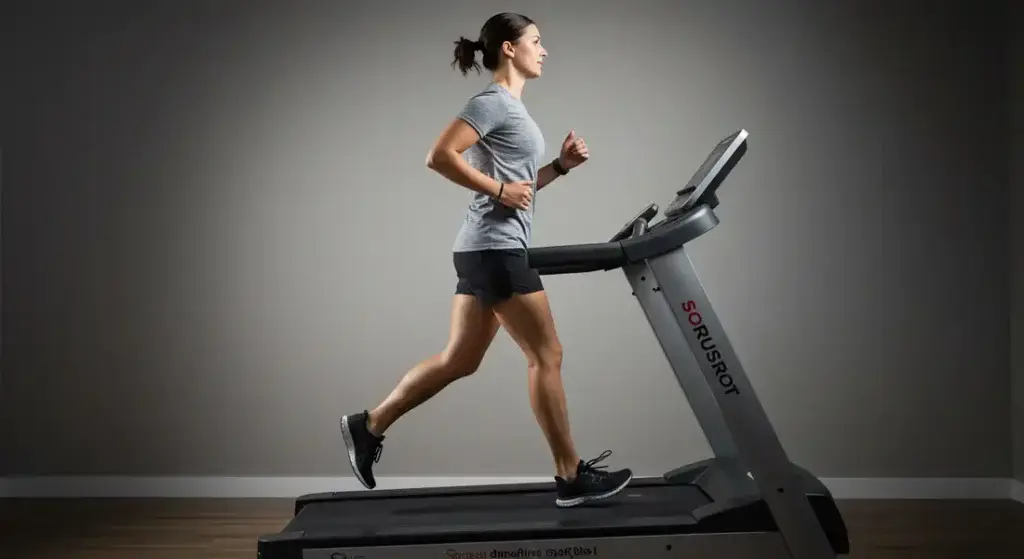
Feeling ready to pick up the pace a little?
Interval training – alternating between higher and lower intensity periods – is a highly effective way to boost cardiovascular fitness and make workouts more dynamic.
We’ll start very gently.
- Goal: Safely introduce short bursts of light jogging (or faster walking), improve cardiovascular response, add variety.
- Structure – Walk/Jog Intervals:
- Warm-Up (5 min): RPE 2-3 (Slow to easy pace walk, 0% incline).
- Main Set (15-20 min): Alternate between these two phases:
- Recovery Walk (2-3 minutes): RPE 3-4 (Return to your Easy Pace walk. Focus on catching your breath and feeling recovered).
- Jog Burst (30-60 seconds): RPE 6-7 (Increase speed to a light jog where talking becomes difficult. The exact speed doesn’t matter as much as reaching that challenging but controlled effort level for the short duration).
- Repeat this walk/jog cycle 4-6 times total.
- Cool-Down (5 min): RPE 2-3 (Finish with an easy, slow walk, 0% incline), followed by stretching.
- Beginner Tip: Your “jog” burst can absolutely be just a much faster walk if you’re not ready for jogging! The key is the contrast in effort between the burst and the recovery. Keep the bursts short to start (30 seconds is great!). Ensure you feel well-recovered during the walking portion before starting the next burst.
- Progression: Introduce changes very gradually once the current structure feels comfortable. Choose one option: Slightly increase the duration of the Jog Burst (e.g., from 30s to 45s), OR slightly decrease the Recovery Walk time (e.g., from 3 min to 2.5 min), OR add 1-2 more walk/jog cycles to the total workout. Don’t try to change everything at once!
Putting Your Building Blocks Together – Sample First Few Weeks
How do you combine these? Be flexible, listen to your body, and prioritize rest.
Here’s a possible schedule:
- Recommendation: Aim for 3 to 4 workout sessions per week initially. Allow rest days in between for recovery – this is when your body adapts and gets stronger!
- Sample Weeks 1-2 (Focus: Consistency):
- Workout Day 1: Foundation Walk (Focus on completing the time comfortably)
- Workout Day 2: Rest or very light activity (like stretching)
- Workout Day 3: Foundation Walk
- Workout Day 4: Rest
- Workout Day 5: Foundation Walk (Maybe try adding 2-3 minutes to the main set if feeling good)
- Workout Days 6 & 7: Rest
- Sample Weeks 3-4 (Focus: Introduce Variety – If Ready):
- Workout Day 1: Foundation Walk (Perhaps a bit longer or slightly faster if comfortable)
- Workout Day 2: Rest
- Workout Day 3: Gentle Hill Explorer (Start with low incline/short duration)
- Workout Day 4: Rest
- Workout Day 5: First Steps Into Intervals (Start with 30s bursts, long recovery walks) OR another Foundation Walk if intervals feel like too much yet.
- Workout Days 6 & 7: Rest
Remember: This is just a template! Feel free to stick with Foundation Walks for several weeks if that feels right. Progress at your own pace.
What Comes Next? (A Tiny Peek Ahead)
Once you’re comfortable with these beginner blocks for several weeks or months, progression might involve:
- Gradually increasing the duration of your workouts.
- Increasing your steady-state pace (walking faster, jogging more consistently).
- Making interval bursts longer or more intense (faster speed) and recovery periods shorter.
- Trying out some of the pre-set programs on your treadmill’s console if you have them.
But for now, focus on mastering these initial building blocks!
Conclusion
Starting your treadmill journey is exciting, and it doesn’t need to be complicated!
By using these simple workout building blocks – the Foundation Walk, the Gentle Hill Explorer, and the First Steps Into Intervals – you have a clear path forward.
Remember to prioritize the Golden Rules: listen to your body, always warm-up and cool-down, and focus on your perceived effort (RPE) rather than just speed numbers.
Consistency is your greatest ally.
Embrace the process, celebrate small improvements, and enjoy the feeling of getting stronger and healthier with each step.
You have the tools – now go enjoy your workout!
Ready to put theory into practice?
Mastered the safety checks? Choose the Foundation Walk above and get started today!
Need a quick refresher on safe operation? Revisit the Treadmill Safety Guide.
Want the big picture on treadmills for beginners? Head back to the Ultimate Beginner’s Guide to Treadmills.
